#Yuzuru Tachikawa
Explore tagged Tumblr posts
Text










Blue Giant (2023) | dir. Yuzuru Tachikawa
33 notes
·
View notes
Text
Animation Night 191 - Yuzuru Tachikawa

this is what it's like to play jazz.
OK, so, you know Mob Psycho 100? Maybe I don't even need to say more than that...
Yuzuru Tachikawa! If you're a sakuga type, perhaps a familiar name... if not, let's take a moment to rewind the clock to the strange ancient times of 2013, where there was a certain something called the Young Animators Training Project. Which was a project to train young animators. More substantially, as kvin writes here, it was a project designed to address the collapsing training processes of the anime industry... a project which fell rather short of its aims in many ways.
But in its earlier days, it did fund a couple of very interesting, unique short films. One of them was the original Little Witch Academia, which went on to expand into one of Trigger's flagship series. And the other... was Death Billiards, directed and written by a certain Yuzuru Tachikawa, rising episode director star, at Madhouse.
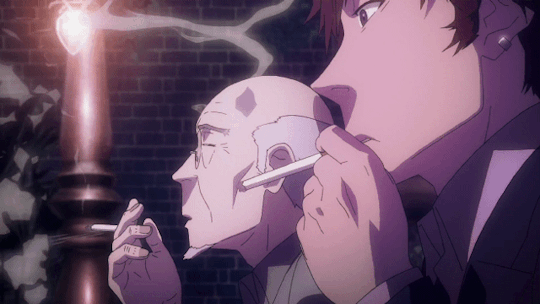
The premise of Death Billiards, and the later expanded esries Death Parade, is that the dead find their way into bars whose bartenders judge whether they should be reincarnated based on 'death games'. What's a death game? Well, standard bar stuff: billiards, darts... the title is in fact very literal. And it slapped. kVin writes:
Death Billiards was nothing short of a passion project for Tachikawa, who wrote, directed, and storyboarded it all. It was his opportunity to make a stance. To prove he wasn’t just a great ally for other creators, or even a suitable second in command, but rather someone deserving of helming his own titles as he pleased. In his second showing as director—the one fan of the 2012 multimedia project Arata-naru Sekai happens to be a friend of mine and he’ll kill me if I don’t mention it—Tachikawa held nothing back. Death Billiards’ exploration of ambiguity and moral failings that had always intrigued Tachikawa stuck with people all around the world too, and its presentation was so stylish that not even Yoh Yoshinari’s dazzling LWA managed to overshadow it. The OVA immediately put Tachikawa on the map, but truth to the told, that’s far from the extent of its success.
And indeed, Tachikawa - and producer Takuya Tsunoki - went on to do many great things, building up a strong gang of animators around them, many of them associated with the young Studio NUT. Of course, their best known project is Mob Psycho 100, a popular comedy-shōnen manga by One (same mangaka as One Punch Man) which plays around with chuunibyou (in the original sense) ideas of psychic powers in, ultimately, a very grounded, affirming way - and to this Tachikawa et al. brought a slightly sketchy, experimental style which led to some pretty crazy action animation. Mob was a crazy hit; later came their long-term passion project DECA-DENCE, a very fun scifi piece about humans trapped in an elaborate physicalised game, rebelling against the system and staging prison breaks, full of slick zero-g action sequences...
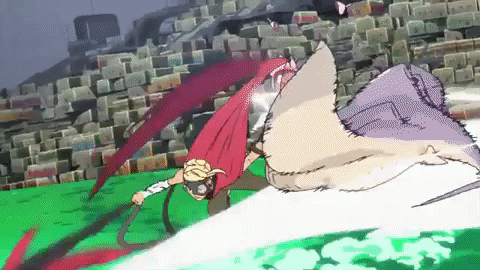
Course while we're talking about NUT, we gotta mention their first work Youjo Senki, perhaps the most outright loathsome anime I've ever seen. Not to beat this dead horse. I can only imagine that the staff working on it were like... somehow oblivious to the blatant nazi barely-even-subtext of what they were adapting? (In keeping with the unfortunate ways that otaku culture plays with nazi imagery.) I just can't square it with any of the other stuff they've made, Deca-Dence in particular. Tachikawa at least was only peripherally involved in that hot mess.
We're not actually here to talk about Mob or Deca-Dence though - they're both way too long for Animation Night. Instead we'll be rolling the clock forward to Tachikawa's most recent project at NUT: an adaptation of Blue Giant, about boys playing jaazzzzzz.
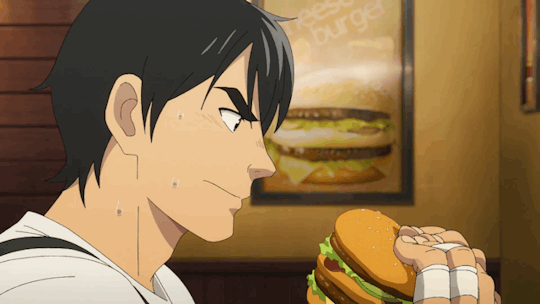
also eating burger.
Blue Giant follows Dai, an aspiring saxophonist, as he grows up and toots despite the hostility of the patrons of his local music shop. The film adapts some of the later volumes of the manga, in which Dai has already made some progress in his playing. Dai falls in with two other jazz players: the experienced and arrogant Yukinori and novice drummer Shunji as they form a band. Before long, conflict brews over just how hardcore you should go.
The film is, naturally, a celebration of jazz, full of elaborate scenes of performance, described as being like "a full-blown music video" to really sell you on how moving and awesome jazz movie can be. Jazz and anime can be a great combo (just ask anyone who's seen Cowboy Bebop or Gundam Thunderbolt) and I am pretty curious to see what they come up with here.
Honestly, while I've enjoyed Mob and Deca-Dence, I definitely feel like I'm sleeping a bit on Tachikawa - so tonight I hope to remedy it by checking out where he came from and where he's currently going, with a night of Death Billiards and Blue Giant! NUT's animation is always lively and stylish - they're also the studio where the master of anime-industry animation tutorials, Dong Chang, works - so I think we'll surely see something cool.
Animation Night 191 will be going live shortly at twitch.tv/canmom, I hope to see you there! And apologies for the late start - without going into too much of what's happening behind the scenes here, we should (touch wood) soon be able to get back to an earlier schedule, but for now we're still on witching hours.
28 notes
·
View notes
Text

Blue Giant
directed by Yuzuru Tachikawa, 2023
21 notes
·
View notes
Text
"I want to depict the meaning of living." Interview with Death Parade Director, Yuzuru Tachikawa
[Part 1]
Continuing from the first part of the interview, the second part delves deeper into the making of Death Parade with director Yuzuru Tachikawa. We inquire about his staff and his technique as we explore his production process. The Visual Emphasis Was on Attention to Detail [Part 2 of 2] — In the second part of the interview, we will mainly discuss your role as a director. Did you establish any guiding principles for direction while working on this project?
Tachikawa: We discussed not wanting to include too many unnecessary camera movements, so we planned the sequences around fixed shots. This was to ensure that the focus remained on the detailed craftsmanship of the visuals. If we weren't careful, we would end up with more than 300 cuts just within the bar (laughs). — Yes. that's right. Tachikawa: Since we have to stage the scenes in the same location most of the time, using the usual shot-reverse shot technique would make all the cuts look the same. So at the storyboard stage, I asked for the camera positions and pacing to reflect the characters' emotions. I wanted the structure of the composition to maintain a sense of tension throughout the scene.
— The storyboard for Episode 2 was done by Satō Yūzō, the director of Tohai Densetu Akagi -Yamini Maiorita Tensai- and Kaiji: Ultimate Survivor. Was he chosen because you wanted to expose the tension of a psychological battle?
Tachikawa: Actually, the original concept for that episode revolved around mahjong (laughs). But that got scrapped, and Sato was assigned to Episode 2.
— If the mahjong story was done, that would have been interesting (laughs). Earlier, you mentioned that you wanted to emphasize the detailed craftsmanship of the visuals. I heard that you have incorporated 3D layouts this time. What is the reason behind that?
Tachikawa: To start, the room inside the bar is extremely difficult to animate. It’s deceptively wide and circular…drawing curves can be challenging. When we did Death Billiards, we aimed to train young animators, so everyone drew it by hand. But the struggle with layouts alone consumed half of the schedule. If we did the same thing in a TV series, the production would definitely collapse. So this time, we created the bar in 3D and asked the key animators to focus on drawing the characters’ performances. That's why we opted for 3D layouts.
— Was this approach something that you had experienced in previous projects you had participated in? Tachikawa: In the project Terror in Resonance, which I participated in just before this one, we also used 3D for locations like the hideout used in a prolonged scene.
― You were also an assistant director for Terror in Resonance, right? How did you use your experience during that production for this one?
Tachikawa: Yes, that's right, and the direction of both works is quite similar (laughs). Actually, even the direction plans felt close to Director Watanabe Shinichirō's. We had many discussions where I thought, "ah, yes, that's right." I wanted to see Director Watanabe's work up close, so I participated in Terror in Resonance, and I was glad that there were many aspects of it that intuitively made sense to me.
― When you say that the directing plans are similar to Director Watanabe's, what exactly do you mean?
Tachikawa: It’s regarding how we create the visuals and structure the cuts. Terror in Resonance also focuses on crafting the visuals based on a fixed camera, using angles that are more typical of film. The approach is closer to live-action, and in that sense, I think we are similar.
Staffing and Their Tasks
― In this work, there is a position for key animators, but what exactly are they responsible for?
Tachikawa: The key animator is the person who is in charge of the most important part of the animation.
― Three main animators are credited. Could you tell us about their primary responsibilities?
Tachikawa: Tokura-san is good at effects animation, so he does a lot of cuts like that. In each episode, he draws the smoke effects when the game machines come out. Besides effects, he also draws various other elements, but his main focus is on those parts. I asked Ishibashi Shōsuke-san to do the original drawings for the parts where the characters' emotions are running high and more sides of their personalities are exposed. He joined from Episode 4 onwards. For instance, he animated scenes like the one where Misaki was running while shouting “Stop messing with me!," and the scene later on where she was caught up in threads and crying out. Kojima-san similarly works on scenes where the characters' emotions explode. For example, in the latter half of Episode 1, where Takashi shouts while gesturing, "That’s not my child! It has to be someone else’s!." He tends to enjoy working on scenes that are not typically depicted in anime.
― Regarding the staffing, Director Shishido Jun from Hajime no Ippo: Rising is listed as the Chief Director. What exactly is his role?
Tachikawa: At first we thought about an assistant director position, but then it was decided that someone with a career as long as Shishido-san's would not fit well as an assistant director for a rookie director like myself. So, rather than focusing on assistant director duties, he mostly assists in directing aspects at key points, which led to the title of Chief Director.
― What specifically does Shishido-san do?
Tachikawa: He's responsible for requesting the storyboards and directors for each episode. He also assists in checking the work when I become busy with other tasks. Additionally, he occasionally takes on assistant director tasks as well.
― Similar to Death Billiards, the artistry in this work is also incredibly intricate.
Tachikawa: Art Director Hirayanagi Satoru also worked on Death Billiards. For the previous work, we commissioned Studio Easter for background art, but now he has established his own art team called Heikuro. In this series, we show places like behind the bar, which wasn't shown in Death Billiards. When creating such things, we would submit new images, and after discussing them with him and his team, they would put them together into something that would suit this universe.
― How do you balance the art and 3D layout?
Tachikawa: For Quindecim's bar, we model it in 3D and apply textures. By creating it in 3D, we can freely move the camera inside the room. So, for Quindecim's layouts, the art department adds retouches to the still images created from 3D data. As for other settings, they are drawn from scratch.
― In Death Billiards, Murakami Izumi, who was a young key animator, is now in charge of prop design.
Tachikawa: Murakami-san has always had an original sense of creativity. She's responsible for designing small items and the design of Ginti's bar, and we ask her to come up with unconventional ideas.
― Ginti's bar filled with kokeshi dolls was quite amusing.
Tachikawa: In Ginti's bar, there's a large hand statue, and that idea also came from her. She's also involved in key animation, and she draws intricate movements as well.
― How do you delegate tasks between her and Akishino Denforword Hiyori, who also works on prop design?
Tachikawa: Akishino-san mainly works on designing the games featured in the story. Murakami-san is based in the studio, so we can discuss and work together easily. Akishino-san works from home, so we asked for things that are easier to explain, like dartboards.
― The music is handled by Hayashi Yuuki, right?
Tachikawa: Yes, I specifically requested Hayashi-san. I really liked the music he created for the TV drama Strawberry Night. I had the sound director create a music menu, and I communicated my vision and the kind of image I wanted for the music. Opening and Ending
— Please tell us about the much-discussed opening. What was the reason for making the opening more upbeat, contrasting from the main story?
Tachikawa: We had always discussed making the opening bright and enjoyable, especially since the main story tends to be rather dark.
— I think it was a great success, betraying the audience's expectations in a good way.
Tachikawa: Thank you (laughs). If we were to add an opening to the previous work Death Billiards, I think it would have had darker imagery, but I wanted to dispel that image.
— I see. So you wanted to separate it from the image of the work.
Tachikawa: That's right. I hoped that if you feel down after watching the film, the opening will cheer you up.
― (laughs). Was the music the starting point for this, and then you developed the imagery?
Tachikawa: We had the image of how we wanted it to be first. The music we received afterward matched that image quite closely, so it expanded from there.
— It is interesting that the characters are dancing so seriously.
Tachikawa: Throughout the sequence, the arbiters are actually listening to that song. That's why everyone is dedicated to it. Some of the characters are more reluctant, but that too is incorporated into the way each of them dances according to their personality. ― Please tell us about the ending as well. Director Shinichiro Watanabe, mentioned earlier from Terror in Resonance, handled the storyboards and direction, right?
Tachikawa: Because of how tight the schedule for Terror in Resonance, Watanabe-san told me, "If you ever need any help, let me know." Since the main story has a heavy workload and Watanabe-san has another job lined up, we decided he could handle the ending. We conveyed the essence of this work and asked him to create the visuals by summarizing the concept.
― Just like the opening, the show proper seems to have a sharp sense of humor. Episode 6, Cross Heart Attack, which is a gag episode, was also very entertaining. What are your thoughts on humor in this series, Director Tachikawa?
Tachikawa: Rather than consciously thinking, "Let's make people laugh like this," I just did what I liked, so it came out organically. Someone told me that my comedy tends to be surreal. I like when jokes come at unexpected times. In Death Billiards, for example, there was a scene where an old man's dentures flew out after he hit the glass. In the sixth episode of this series, there's a moment when Mayu is about to fall and get pierced by a needle, which then becomes a gag. I think I enjoy the contrast between seriousness and comedy. If it's comedy all the time, it becomes monotonous, right? Before doing comedy, I intentionally insert tense elements and create a contrast, so that's where I aim for laughter.
― Decim also has quite a mischievous side. Is that also aimed at creating contrast?
Tachikawa: Yes, that's right. And Decim has a cute side too, so I thought I'd stretch that a bit.
— (laughs). (Laughs.) Is the change in Decim a key point in this story?
Tachikawa: Yes. I think that will be an important part.
― As the show is enters its final stages, could you tell us about the highlights of the second half?
Tachikawa: In Death Parade, we are trying to depict the essence of human "life." To that end, we need to define what it means to be "alive" within the story. I personally believe that the purpose of living lies in facing and embracing everyone’s individual qualities and destinies, while actively making choices that shape our own paths. This aspect might be related to the core of this work.
― It seems to have philosophical themes. Do you often think about human life and death?
Tachikawa: No, not often (laughs). ━┅━┅━┅━┅━┅━┅━┅━┅━┅━┅━┅━┅━┅━┅━┅━┅━┅━┅━┅━┅━┅━┅━┅━┅━┅━┅━┅━ NOTE: I am not fluent in Japanese! I translated this with the help of a language partner. However, as neither of us are fluent in one another’s native tongue, there may be errors in the translation. I typically don’t share things I translate in my free time, but since no one has tackled these interviews in nearly 10 years, I figured it was nice to put these out there for folks who may be interested.
#death parade#cloudytranslates#yuzuru tachikawa#anime#anime interview#interview#decim#mayu#ginti#chiyuki#death billiards#manga
7 notes
·
View notes
Photo
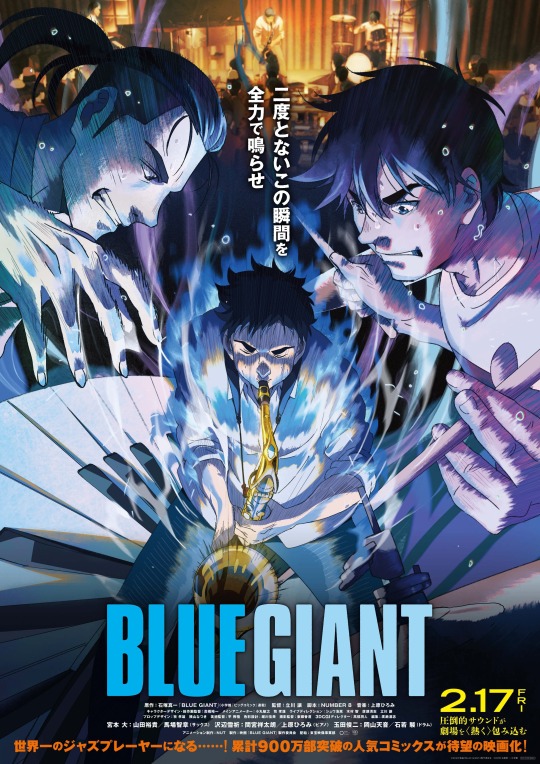
BLUE GIANT
Directed by Yuzuru Tachikawa 立川譲 2023 Japan
34 notes
·
View notes
Text

Blue Giant (id., 2023).
#póster#cartel#cinema#movie#film#filme#cinefilia#cinephile#cine#anime#animación#Blue Giant#manganime#cinecómic#Nut#Yuzuru Tachikawa
4 notes
·
View notes
Text

"Chiyuki"
Chiyuki was a surprisingly nice character! I don't often love female character in anime, so... x3
#art#drawing#illustration#digital#digital artist#artists on tumblr#digital art#oc#character#painting#digital drawing#digital illustration#digital painting#chiyuki#death parade#yuzuru tachikawa#yuzuru#tachikawa#anime#manga#anime fanart#fanart#fan art#fandom#manga art#manga fanart
12 notes
·
View notes
Text




















TERROR IN RESONANCE | 残響のテロル | Season 1, 2014
Shinichiro Watanabe + Kazuto Nakazawa + Yuzuru Tachikawa
5 notes
·
View notes
Text
REVIEW: Blue Giant (2023)
A Film directed by Yuzuru Tachikawa The moment that I first saw the trailer for Yuzuru Tachikawa’s film Blue Giant, I knew that it was something that I would absolutely need to see. I’m not even a fan of jazz music, have never read the manga that the film is based on, and am not too familiar with anyone that made it. That all said, Blue Giant is the sort of property that absolutely needs support…

View On WordPress
#animated#animated film#anime#anime adaptation#Blue Giant#film#GKIDS#Japan#Japanese#jazz#jazz music#Movie#Movie Review#Shinichi Ishizuka#Yuzuru Tachikawa
2 notes
·
View notes
Text

Blue Giant (2023) Yuzuru Tachikawa.
1 note
·
View note
Text
Blue Giant (Film Review)
Continue reading Blue Giant (Film Review)
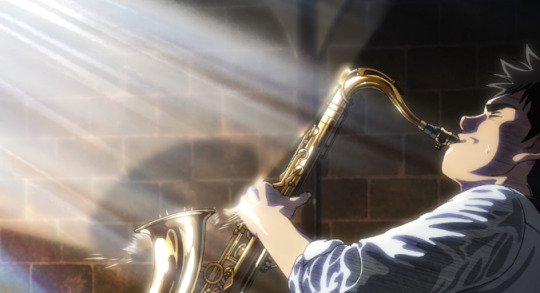
View On WordPress
0 notes
Text
BLUE GIANT:
Young jazz prodigy
Starts a band in Tokyo
Long road to success
youtube
#blue giant#random richards#poem#haiku#poetry#haiku poem#poets on tumblr#haiku poetry#haiku form#poetic#anime#yuzuru tachikawa#NUMBER 8#Shin’ichi ishizuka#shinichi ishizuka#jazz#shotaro mamiya#Amane Okayama#yuki yamada#Youtube
0 notes
Text
【ワートリ】VS.


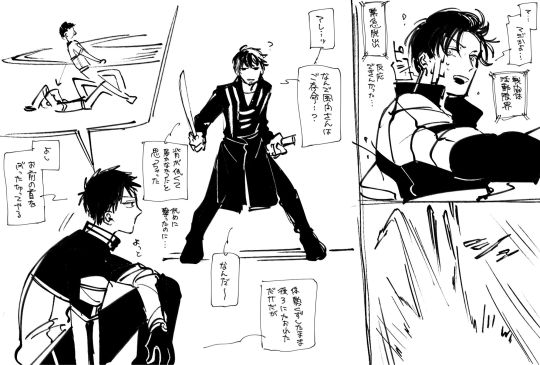



戦闘シーン描くの���しい🤗
#ワールドトリガー#world trigger#fanart#太刀川慶#tachikawa kei#風間蒼也#kazama soya#佐伯竜司#saeki ryuji#絵馬ユズル#ema yuzuru#菊地原士郎#kikuchihara shiro#嵐山准#arashiyama jun
60 notes
·
View notes
Text
Interview with Yuzuru Tachikawa - director of Death Parade - about his insights on his creative process.
The enjoyment of standalone episodes lies in the ability to try various challenges [Part 1 of 2]
Death Parade is an original TV anime released by Studio Madhouse. It is a work known for its deep human drama that offers glimpses of human frailty and love, supported by its rich visual storytelling. It's worth noting that this is the first TV anime born from the Agency for Cultural Affairs' Young Animator Training Project, Anime Mirai. Leading the project as the original creator, series composer, and director is Yuzuru Tachikawa, a rising director who has garnered attention for his various works.
Yuzuru Tachikawa Anime Director. After graduating from the Department of Film Studies at the Faculty of Arts of Nihon University, he joined Studio Madhouse. He made his directorial debut [on episode 51 of] Kiba and served as assistant director for Chi’s New Address. He later became freelance and gained attention for his episode direction in works like BLEACH. In 2012, he made his directorial debut with the OVA Arata-naru Sekai and in 2013, he served as the original creator, scriptwriter, and director for his own work Death Billiards as part of Anime Mirai 2013.
Changes from Death Billiards
— Let's talk about the project. This work is original, and it marks your debut as a TV anime series director. It seems like it would be rather difficult to pitch such a challenging project. What was the deciding factor?
Tachikawa: I think it was due to Death Billiards, the previous work we produced for Anime Mirai 2013. Without this work, I think it would have been difficult to get this project through with just a typical proposal. The fact that we had a complete film was an advantage. It was important to have a clear image of the finished film for the people who gave the go-ahead for the project, as well as the production committee.
— The title has changed from Death Billiards to Death Parade. What was the reason behind this change?
Tachikawa: The provisional title during the planning stage was actually Quindecim. However, the word "death" leaves an impact, doesn't it? Even with Death Billiards, people found amusement in the absurdity of combining two words which wouldn't normally go together. So, this time, I went with "Parade." Originally, Death Parade was the subtitle for each episode, but it was elevated to becoming the title of the series. The image I wanted to convey was a sort of parade through which many dead people arrive. [TL Note: this might seem repetitive and obvious but he is explaining the title as one would to a Japanese speaker, without using the English word for “death” here.]
— Were there any deliberate changes you made from Death Billiards?
Tachikawa: With Death Billiards, I intended for it to work as a standalone film, so there were parts towards the end left ambiguous or deliberately obscured to leave an impression and linger with the audience. However, I thought that if we did that in every episode of the TV anime, it would just add unnecessary pressure. So the dark-haired woman, who had a more detached role in Death Billiards, was placed in a position closer to the viewer to alleviate that.
— One of the major differences from the previous film is the introduction of new arbiters such as Ginti and Nona. Was the intention to increase the number of characters a consideration unique to a TV anime format, as you just mentioned?
Tachikawa: That was one aspect, yes, though what I wanted to focus on wasn't just the humans, but the arbiters themselves. That's why we ended up with more characters.
— So will the second half of the episodes be centered on the arbiters, then?
Tachikawa: I hope you look forward to it. In the latter half, we'll touch more on the themes of the work, but in addition to the usual character performances and game interactions, I also want viewers to pay attention to the development of Decim and the dark-haired woman, who are the main characters.
The first episode shouldn't be the most interesting one
— When creating new characters, what kind of orders did you give to character designer Shinichi Kurita? Tachikawa: Kurita-san's art style tends to lean towards realism, but since we started producing Death Billiards, I was careful not to make it too realistic. Since I wanted the characters to have drastically shifting expressions, rather than making them overly stylish or polished, I aimed for something a little off-balance. That approach has been continued in this work as well.
— This is your first time directing a TV anime. Did you feel any pressure?
Tachikawa: I've been involved in TV series productions quite a bit, so I understood the general flow of directorial work. I thought I had a grasp on the workload, but it turned out to be more than I expected when I actually did it.
— Was it also because you wrote the script as the original creator?
Tachikawa: Yes, indeed (laughs). There was so much to do that I sometimes felt pressured midway through, thinking, "has it always been this much?"
― You say there was a lot of pressure, but as a viewer, I was impressed by how deliberate the production seemed, to the extent that one wouldn't think it was your first time directing. Various elements seemed well-controlled and utilized effectively, like how some material from the first episode was reused in the second, and how the action was strategically employed.
Tachikawa: I'm grateful to hear that. Regarding the distribution of effort, it was decided during the series composition phase where to have ups and downs. I believe it's not good if the first episode is the most interesting throughout the series. We need to keep building excitement towards the latter half. So, if there's a peak point, I thought it's important to intentionally lower the tension afterward and then build it up again. It's not about maintaining high tension from start to finish, but about balancing the ups and downs.
— Speaking of scripts, you're credited for series composition. Kenta Ihara is also credited for "screenplay cooperation." Could you explain how the work was divided?
Tachikawa: I had a slightly unconventional way of working on the script. At the beginning, I wrote the entire storyline I initially had in mind, all the way through to the final episode. Then, when going back to create the scripts, since I already had the story fully formed in my mind, I simply needed someone to provide objective feedback. This could be a producer or someone from the studio, but I thought it would be best to have input from a third party, especially a writer. So, I brought in Ihara-san for that role. He's actually a friend from my university days, and writes scripts for dramas.
— Oh, I see.
Tachikawa: I thought that a writer who had already worked with me in the past might be hesitant to be up front with me. I wanted someone who could give me direct feedback, so I asked him to join the project.
— Were there any parts that were revised based on Ihara-san's input?
Tachikawa: By the time Ihara-san joined, the structure was mostly set, so he provided guidance mainly on the most crucial points that needed adjustment. The first three episodes remained largely unchanged, but for the latter half, Ihara-san and I met more often, and we delved quite deeply into it together.
Characters' answers are presented objectively
— The second episode, "Death Reverse," serves as a sort of answer to the first episode, but was that structure planned from the beginning?
Tachikawa: No, that came about during the process of refining the script. Initially, I had planned to bring the answer section around the middle of the series. And the series initially started with the dark-haired woman already being in the bar. — So the setting was more similar to Death Billiards.
Tachikawa: But we changed the storyline halfway through the production because some people thought it would be more natural to start with their first encounter. At that time, we reorganized the story so that we would look back at what happened in the first episode from the dark-haired woman's point of view.
— You present what seems to be the correct answer to what the characters in episode 1 were going through in the next episode, but there are plenty of other interpretations possible, aren't there? For example, one could interpret it as Machiko falling into despair and emptiness after completely losing faith in her husband, who had lost his trust in her. How was this aspect considered? Tachikawa: In the first two episodes, I mainly wanted to convey that this work doesn't disregard all possibilities, and it leaves the interpretations of events up to the viewers. Even if the answers reached by the main characters aren't necessarily the truth, I felt it was necessary to present them authentically. The dark-haired woman believes something along the lines of, "Machiko intentionally became the villain to protect her husband," so that's what she says. It's not that this is definitively the "correct answer," but rather that it's not explicitly presented whether it is true or not. The dark-haired woman comes up with her own answer, Decim comes up with his own answer, and Nona, who was also present, arrives at yet another. — That’s true, the viewers get to hear all their different perspectives.
Tachikawa: On the other hand, it's debatable whether what Machiko said actually protected Takashi in the first place. Takashi is breaking down, and while he might have been freed from the guilt of killing his child, his life and love with Machiko has become a lie. Machiko meets her fate with a pained expression, but whether or not her actions were justified is another story. That said, while we try to keep outcomes ambiguous, we do aim to convey the feelings of each individual character and the answers that they personally come to in the end.
— With the exception of the first two episodes, the stories in the first half are basically standalone, right? Each episode introduces new guests and a new game. These days, it's rare to see an original TV anime where each episode ends with a standalone story.
Tachikawa: We wanted to challenge ourselves in a variety of ways, and that's why we made the episodes self-contained. One aspect of this is that it allows us to tackle a variety of topics. It’s fun to aim for a comedic tone, or maybe try a romantic subject; there’s a lot we can explore with this format. I also like the challenge of being able to create a complete narrative arc within the relatively short duration of each episode. Plus, I think viewers would get tired if they were only presented with intense stories all the time.
Conversational drama like a stage play and passionate performances by the cast
— One of the highlights of each episode is how the guests have different perspectives and gradually reveal their true feelings. Were there any conscious decisions in how to present this?
Tachikawa: When writing the script, I was conscious of creating an atmosphere that feels somewhat like being close to a stage, where the audience is right nearby.
— So, is it like engaging with the audience below the stage?
Tachikawa: Yes, that’s right. Also, regarding the dialogue, I wanted to structure it so that a character’s statement could be contracted by the other. Since everyone has a different perspective, I wanted to craft dialogue where they could refute one another naturally. I focused on ensuring that the tempo of the conversation flowed smoothly without dwelling on which line of dialogue was correct. For example, in episode 4, we have Misaki, a celebrity with a large family. What she feels stems from her background, but whether that resonates with Yosuke, a shut-in, isn’t clear. As mentioned by their actors, Morita Ichisei-san and Yamaguchi Yuriko-san, during the guest talk, the two of them appear to be having a conversation, but in reality, they are not truly communicating. Their perspectives are completely different, so even though they appear to be engaging with one another, their feelings are not reaching the other at all.
— Now that you mention it, I think there's an interesting aspect to the open-ended conversations scattered throughout the show. Tachikawa: I intended for the guest voice actors to perform their roles as though they were on stage, much like the kind of acting you'd see in a play. This series itself is crafted somewhat like a locked-room drama. It's about drawing out emotions from the interactions, almost like a vocal battle. Professional voice actors can bring out a wide variety of performances when you ask them to do so, so as a director, I wanted to challenge them in that regard. The sound director, Satoshi Motoyama-san, has been working with us since Death Billiards, so I feel that he understands the direction we are taking and he provides a ton of support accordingly. Since this series offers a snapshot of human life, I believe the passionate performances by the voice actors are a major highlight. ━┅━┅━┅━┅━┅━┅━┅━┅━┅━┅━┅━┅━┅━┅━┅━┅━┅━┅━┅━┅━┅━┅━┅━┅━┅━┅━┅━ NOTE: I am not fluent in Japanese! I translated this with the help of a language partner. However, as neither of us are fluent in one another’s native tongue, there may be errors in the translation. I typically don’t share things I translate in my free time, but since no one has tackled these interviews in nearly 10 years, I figured it was nice to put these out there for folks who may be interested.
As a personal aside, as much as people insist that "anime is cinema" now, the presentation of the medium as a whole has firm roots in theater; particularly manzai, kabuki, and rakugo. Tachikawa's education in film probably prepared him to portray Death Parade with all the gravitas of a live theater performance while incorporating elements of reality television and his usual cinematic techniques, and I think his efforts really paid off here. That his first endeavor as a series creator, writer, and director was something so tightly produced at the age of 30 is no small effort, especially in the state of the industry at the time. There are many Japanese documentaries and essays that explore the connection between anime and theater. Once I get better at translating and become more educated in these topics as a whole, I'd really like to tackle them one day, because I find them fascinating to learn about and I don't think a lot of anime fans I've spoken to here really appreciate the link between the two mediums.
4 notes
·
View notes
Text
Chatty AF 185: Death Parade Retrospective – Part 1
Caitlin, Cy, and Toni celebrate the 10th anniversary of a cult classic by Mob Psycho 100 director Tachikawa Yuzuru!
Episode Information
Date Recorded: October 30th 2022 Hosts: Caitlin, Toni, Cy
Episode Breakdown
0:00:00 Intros 0:02:51 Content warnings 0:04:23 Summary 0:05:45 Background 0:06:57 Deca-Dence 0:09:40 Mob Psycho 100 0:12:58 Tachikawa’s themes 0:15:40 Personal experiences with Death Parade 0:22:42 That OP 0:27:07 Decim 0:33:38 Ginti 0:34:44 Mayu 0:37:23 Chiyuki 0:42:31 They don’t make ‘em like they used to 0:44:18 Ginti (again) 0:48:55 Mayu and Ginti 0:51:26 The administrators 0:53:45 Nona 0:58:45 Similarities to theatre 1:00:41 Outro
29 notes
·
View notes